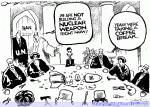By MARC CHAMPION
The Iranian opposition group that first exposed Iran’s controversial nuclear-fuel program has given the United Nations’ nuclear watchdog details of what the group says is a working nuclear-warhead-development facility.
The facility at Khojir, a defense-ministry missile-research site on the southeast edge of Tehran, is developing a nuclear warhead for use on Iranian medium-range missiles, according to Mohammad Mohaddessin, foreign-affairs chief for the exiled National Council of Resistance of Iran.
He also said the NCRI has identified a guest house on a military compound near Khojir that the group says houses North Korean specialists working at the warhead facility. The information was finalized in recent weeks and is current, according to Mr. Mohaddessin.
It wasn’t possible to verify any of the NCRI’s claims independently. Yesterday, Mr. Mohaddessin passed the information, which includes satellite images, to the International Atomic Energy Agency, the U.N.’s Vienna-based nuclear watchdog, and asked the agency to investigate.
An IAEA representative said the organization would check the NCRI’s claim against the agency’s own data and pursue it “if appropriate.”
The NCRI is the Paris-based political wing of the Mujahedin e-Khalq, an exiled military group that has been seeking to overthrow the current Iranian regime since the mid-1980s. The U.S. and the European Union list the group as a terrorist organization.
The NCRI has at least twice given detailed information to the IAEA that IAEA inspectors later verified, including the original information that exposed Iran’s uranium-enrichment program and the location of those facilities in 2002. On at least one other occasion, however, the IAEA was unable to verify information the NCRI provided.
U.S. and IAEA officials have said in the past they believe the NCRI gets its information from a government hostile to Iran, likely Israel. The NCRI denies that and says it develops its information with the help of contacts inside Iran.
NCRI leaders said their latest effort to locate the alleged nuclear-warhead facility was triggered by the Dec. 3 release of a U.S. National Intelligence Estimate concluding that Iran halted its nuclear weaponization efforts in 2003. The NCRI is eager to refute that finding.
The report effectively ended speculation in Washington about a potential U.S. military strike against Iran to cripple its nuclear program. It also undercut U.S.-led efforts to pressure Iran to suspend its uranium-enrichment program, which can be used to produce either civilian or weapons-grade fuel.
Iran denies having any kind of nuclear-weaponization program. It also denies any intent to enrich uranium to weapons grade. The IAEA has said repeatedly it hasn’t found proof of an Iranian nuclear-weapons program. Iranian officials couldn’t be reached to comment yesterday.
Ross Feinstein, a spokesman for the Office of the Director of National Intelligence in Washington, said the U.S. intelligence community’s view hasn’t changed since the NIE’s release.
The NCRI first identified Khojir as a missile facility in 2005. Iran’s medium-range Shahab 3 missile is based on North Korea’s Nodong-1 missile and is believed to have a range of as much as 1,240 miles.
The NCRI’s claim that a small facility on the military base is developing nuclear warheads is new, however. Also new is the claim that North Koreans are being bused to the facility. North Korea is in talks with the U.S. and other nations over its nuclear-weapons program.
The commercial satellite images depict a system of heavy security within the Khojir site restricting access to the alleged nuclear-warhead facility. Visitors to the facility — which is known as “Eight five hundred” — have to leave their cars and drivers behind at the car park, according to Mr. Mohaddessin. A car is then sent to collect the visitors, who pass through two checkpoints to get onto a road that ends at a small group of buildings cut into the hills about 1.25 miles away.










